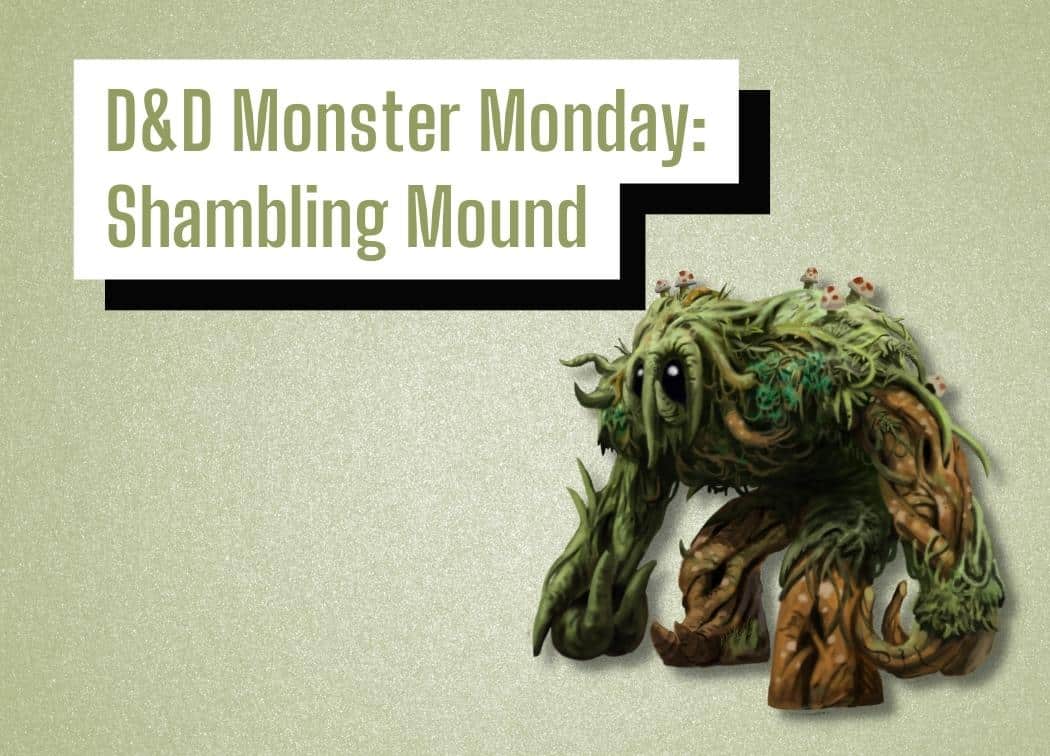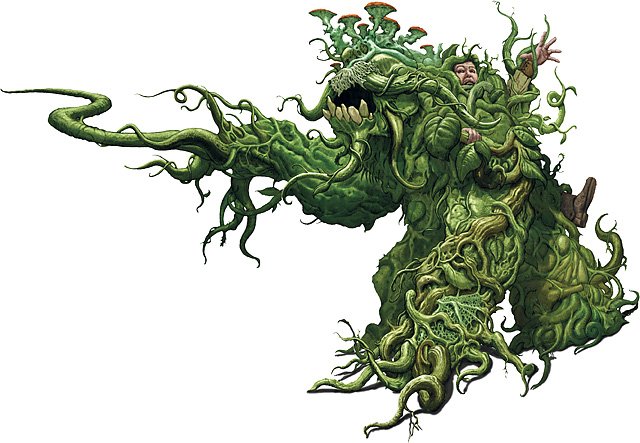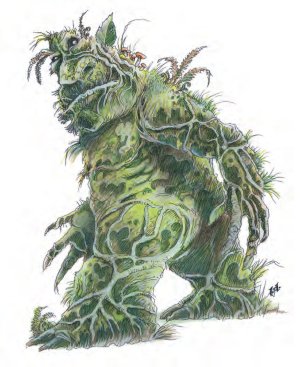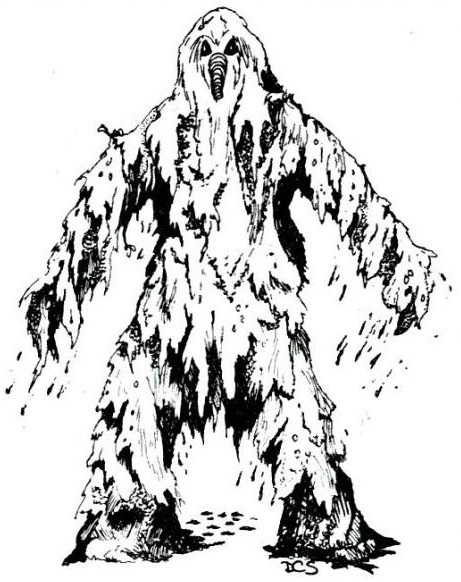D&D Monster Monday: Shambling Mound

You step off the dais in the center of the room, making your way to the exit. Suddenly a hulking pile of trash and vegetation rises from the murky water around you. Of course, a shambling mound was stuck in the waterway this whole time.
Death House has given me some terrifying creatures to work with in the past few sessions of my Curse of Strahd campaign. While the specter was a real scare, the true terror of the Death House was, as expected, Lorgoth the Decayer.
Shambling mounds are weird creatures, but they’re very powerful. They have hearty defenses against direct attacks which, at their CR, is the majority of deadly spells and attacks that the party has access to.
They also have high offensive potential. Their damage is powerful, their action economy is solid, plus they have a deadly single-target crowd control ability that also deals passive damage.
Let’s sulk into the murky swamps of the Monster Manual and learn all about the all-consuming devourer, the shambling mound!

Shambling Mound Lore
Shambling mounds are weird creatures. They’re these hulking behemoths that are also super stealthy thanks to their natural camouflage making them terrifying predators in the various swamps, marshes, and rain forests they inhabit.
What’s even weirder is how shambling mounds are created. A humble swamp plant turns into a shambling mound when it is, and I quote, struck by lightning or pumped up with fey magic.
To be fair, this isn’t weird from a fey magic perspective. Just look at these weird creatures I’ve featured from the Feywild. Shit’s wacky.
The weird part is how lightning striking a random plant creates this sentient, all-consuming, behemoth. This small plant literally just sucks in and absorbs all the animals and plants surrounding it until it becomes this massive mulch creature.
It’s awesome. Weird, but awesome.
Shambling Mound Stats and Abilities
You can find the shambling mound’s statblock on page 270 of the Monster Manual.
Stats
Size: Large plant
AC: 15 (natural armor)
HP: 136 (16d10 + 48)
Speed: 20 ft., swim 20 ft.
STR: 18 (+4)
DEX: 8 (-1)
CON: 16 (+3)
INT: 5 (-3)
WIS: 10 (+0)
CHA: 5 (-3)
The shambling mound’s ability spread is the epitome of high-highs and low-lows. Both of their most-used ability scores, Constitution and Strength, are rock-solid with a +4 and +3 modifier.
Then you look at their Intelligence and Charisma and shudder. Thankfully, these aren’t common saving throw abilities.
However, Wisdom and Dexterity, which are are mediocre at best. Their Constitution is their only positive value with Wisdom being the next highest at +0. Being susceptible to crowd control isn’t a great look for an already slow creature.
Speaking of which, their movement speed is another instance of being either great or awful. 20 ft. of movement speed on land is abysmal. It’s 33% less than the average medium-sized adventurer. However, 20 ft. of swimming speed is great as it’s 5 ft. faster than the average medium-sized adventurer.
Their defenses are both spectacular. 15 AC is fantastic for a creature that isn’t wearing armor and has a -1 Dexterity modifier. 136 HP is beefy as hell. These are not easy creatures to bring down!
Resistances, Immunities, Saves, and Skills
Skills: Stealth +2
Damage Resistances: cold, fire
Damage Immunities: lightning
Condition Immunities: blinded, deafened, exhaustion
Senses: blindsight 60 ft. (blind beyond this radius), passive Perception 10
CR: 5 (1,800 XP)
You’d think a sentient pile of mulch would be easy to spot. I mean, it is, but that’s why it’s so great at hiding. The shambling mound can sit there and wait until the party walks up to this rotting pile of vegetation and then strike. It’s the perfect camouflage!
Cold and fire damage are two super common damage types in 5e. Ergo, the shambling mound has some valuable resistances baked into its statblock, bolstering its already fantastic health.
Lightning, while flavorful, isn’t as abundant. However, we’ll take a free damage immunity. Why not?
Three condition immunities are also quite nice. The shambling mound can still be crowd controlled, but immunity to blinded and deafened are nice perks at least. Exhaustion immunity is more flavorful than anything, but it does showcase that it can essentially chase the party to death without a care int he world.
Blindsight is a great perk, especially for a hunter like the shambling mound. It also limits the party’s avenues of escape. Invisibility won’t cut it with a shambling mound.
Honestly? CR 5 is a bit low. These creatures have rock-hard defenses and high potential damage with some devastating crowd control. They’re terrifying for a CR 5 creature.
Traits and Abilities
Lightning Absorption. Whenever the shambling mound is subjected to lightning damage, it takes no damage and regains a number of hit points equal to the lightning damage dealt.
Immunity to lightning damage was a fun perk, but this makes it even better. Lightning damage heals the shambling mound.
Again, lightning damage isn’t common, especially at low levels, but this is a solid situational perk regardless. It may not ever come up in your games, but the creature is not reliant on it anyway so it doesn’t matter.
Actions
Multiattack. The shambling mound makes two slam attacks. If both attacks hit a Medium or smaller target, the target is grappled (escape DC 14), and the shambling mound uses its Engulf on it.
Slam. Melee Weapon Attack: +7 to hit, reach 5 ft., one target. Hit: 13 (2d8 + 4) bludgeoning damage.
Engulf. The shambling mound engulfs a Medium or smaller creature grappled by it. The engulfed target is blinded, restrained, and unable to breathe, and it must succeed on a DC 14 Constitution saving throw at the start of each of the mound’s turns or take 13 (2d8 + 4) bludgeoning damage. If the mound moves, the engulfed target moves with it. The mound can have only one creature engulfed at a time.
Their Multiattack is a standard two attack action. Unless both of their Slam attacks hit a Medium or smaller target. If they do, the shambling mound gets a powerful third attack. While it’s not guaranteed, it still has an above-average action economy due to this extra 3rd attack.
Due to this the shambling mound does either 26 bludgeoning damage per round or 39 bludgeoning damage per round with an engulfed creature. No matter how you slice it, that’s respectable damage.
Slam isn’t an interesting attack, but it’s reliable. It’s got a +7 to attack and deals a whopping 13 bludgeoning damage. All in all, solid.
Engulf is interesting. There are two ways of proccing it: either with two successful Slams from your Multiattack or by manually grappling a creature and using this as a separate action. The former is clearly the superior method.
Once you use Engulf, the grappled creature becomes blinded, restrained, and cannot breathe. Plus, every round they’ll take 13 extra bludgeoning damage if they fail a DC 14 Constitution save. This is a powerful passive ability.
Shambling Mound Strengths
Iron-Clad Defenses Against Direct Attacks
15 AC while wearing no armor is damn good. Especially when you realize they have a -1 DEX modifier. These creatures are tanky as hell.
Their HP is ridiculous, weighing in at 136 HP. Plus, they have two high-value damage resistances which bolsters their HP.
On top of that, they have such a strong immunity to lightning damage that they heal from it thanks to Lightning Absorption.

High Potential Damage
The shambling mound does a respectable 26 bludgeoning damage per round with their Multiattack. However, when they hit both slam attacks on the same (Medium or smaller) target they can also Engulf them.
Each round the character is Engulfed and fails the DC 14 Constitution saving throw they’ll take an additional 13 bludgeoning damage. This additional damage doesn’t impede on the shambling mound’s action economy either.
In the best-case scenario, the shambling mound can deal an average of 39 bludgeoning damage per round. That’s a hefty amount of damage!
Potentially Deadly Crowd Control
Engulfed is a phenomenal crowd control ability as it completely restrains a creature while forcing them to take damage every round until they break the grapple. An escape DC 14 check is a respectable challenge for most low-level PCs, especially characters that have put off boosting their Strength or Dexterity.
While the restrained, blinded, and grappled conditions, alongside suffocation, are all deadly forms of crowd control wrapped into a single action. The true power behind Engulfed is that it can be used without disrupting the creature’s Multiattack.
It’s free, deadly, crowd control. What’s scarier than that?
Shambling Mound Weaknesses
Susceptible to Crowd Control
For a creature with such potent crowd control themselves, it’s funny to see crowd control as their weakness. Yet the shambling mound’s mediocre Dexterity and Wisdom modifiers have come to bite it in the ass.
Figuratively speaking. I don’t think it has one.
Anything that can slow, restrain, grapple, paralyze, petrify, etc. the shambling mound will decimate this creature. It’s already a slow creature. Any of these conditions will turn it into a sitting duck, making it easier to safely kite it to death.
Contextual Weakness: Slow (On Land)
This is a tough one because while 20 ft. of movement on land is abysmal and a clear weakness. 20 ft. of swim speed is certainly not.
This creature is a real threat underwater due to how limited the party’s movement is if they don’t have a swim speed. It will outpace the average medium-sized adventurer underwater by 5 ft. per turn.
However, on land that same medium-sized adventurer outpaces the shambling mound by 10 ft. per turn. That’s a huge discrepancy.
It’s also a huge weakness to the creature due to its vision having a maximum radius of 60 ft. If a creature is outside of that it will have to rely on guessing, hearing, and smell, none of which are as accurate as its blindsight.
The creature is viable on land and in the water. However, this is a clear weakness and limitation for the party to exploit on land.

How to Play a Shambling Mound
A Convenient Hunter
These are not intelligent creatures. They’re not very wise either.
Shambling mounds are going to go after whoever the most convenient prey is to them. Due to their slow movement on land, this will be whoever is closest to them the majority of the time.
They’ll continue to move closer to their prey and may choose an easier-to-hit target if they have the option. Yet as all-consuming devourers, they just want to eat something they don’t care about who is the most efficient meal.
Once they Engulf, subdue, or kill their target they’ll move onto the next one.
Hide in Plain Sight
The shambling mound is a slow creature on land. Thankfully with its proficiency in stealth and convincing camouflage, the creature has a fighting chance to ambush the party, or at the very least draw the party close enough to reach once combat breaks out.
Even if the party can tell that something is up with that big mound of mulch, leaves, and dirt they may think nothing of it if they’ve never encountered a creature like this before.
That’s the ingenuity of the creature. Its appearance creates a false sense of security which allows it to quickly attack a creature, subdue it, and then devour it.
5 Shambling Mound Plot Hooks
- Disappearing Travelers – Abandoned carriages are turning up along the road that runs through the swamp outside of town. The people and horses belonging to these carriages are nowhere to be found.
- When Lightning Strikes – A terrifying roar came from the swamp during last night’s lightning strike. The townsfolk have never heard anything like it.
- Death and Decay – A circle of druids have noticed a path of death and destruction running straight through the forest. A few days ago, they sent two druids to find the source of this phenomenon, but neither have returned.
- Unconventional Guard Dog – After being cast out from the circle, a druid sought out a comfortable cave. They created a shambling mound to act as a companion and guard for this hide-out to ensure that no one from the circle can disturb them.
- A Destroyed Farm – A farmer’s entire crop was destroyed after a lightning storm brought their pile of compost to life. No one in the town beleives them, but they seem desperate to prove their case.
Conclusions
These slow, hulking behemoths are a real blast to play. I mean, I think they’re pretty bullshit for a party of four level 2’s, but my party of six was able to take down the shambling mound in Death House while riding by the seat of their pants.
They’re fun creatures packed with devastating crowd control, damage, and defenses. Yet, they also come with a few exploitable weaknesses. I’d say they’re tough but fair, but they definitely hit above CR 5.
All in all, I like them. I don’t know that I’d have ever used one if I wasn’t running Death House, but they’re certainly something I’ll consider for homebrew games in the future for a level-appropriate party!
